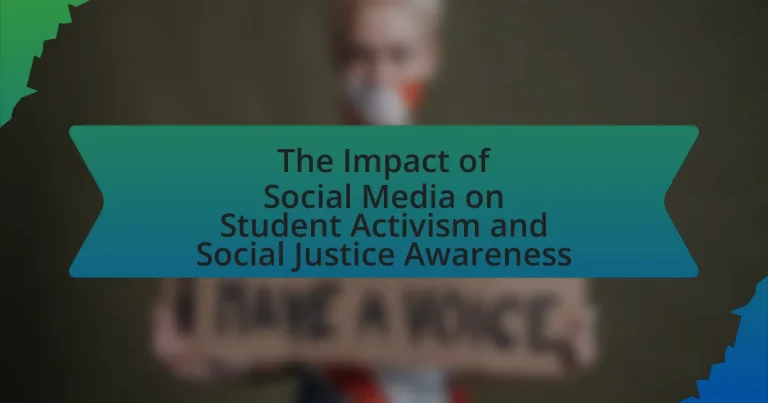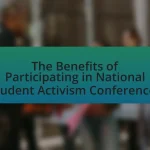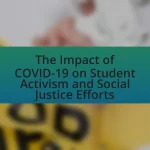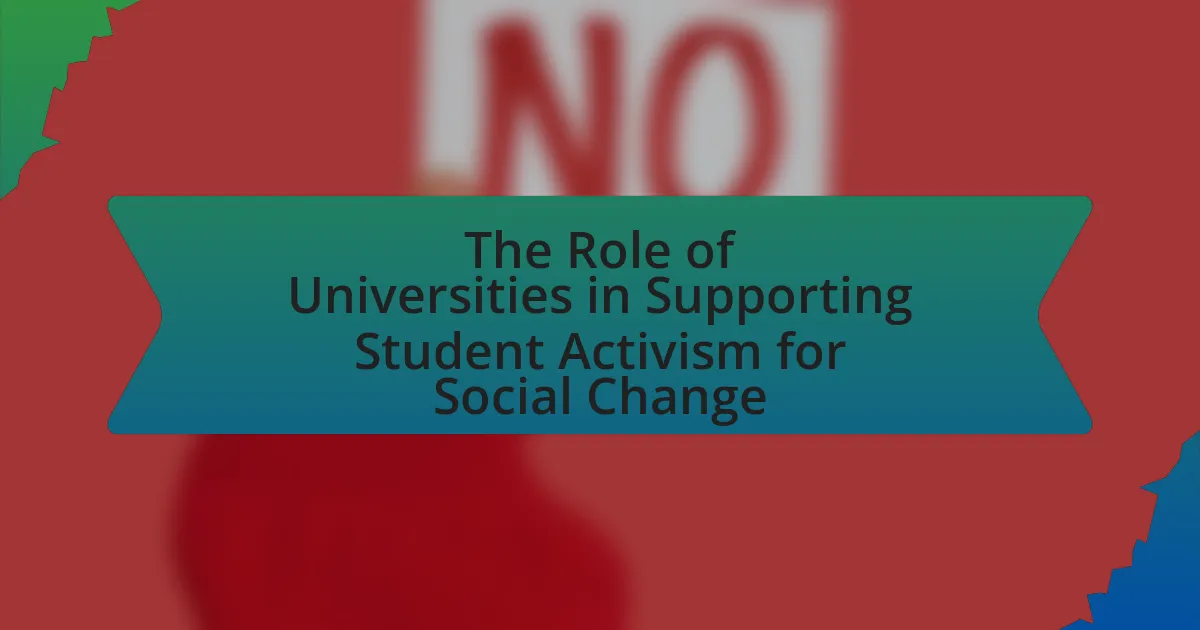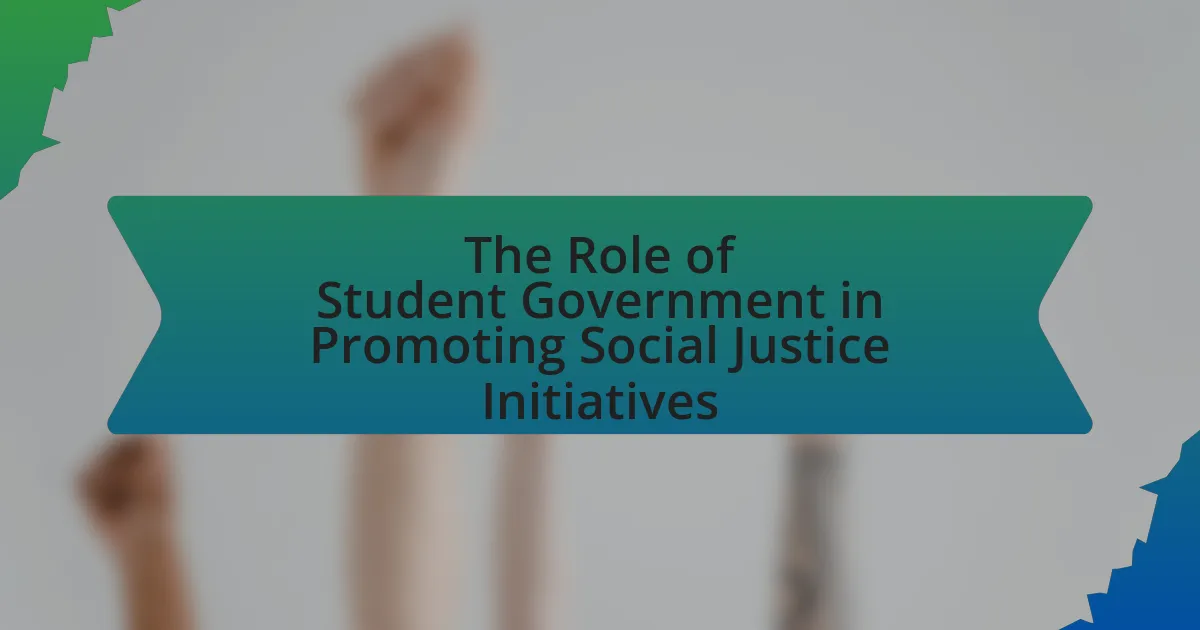The article examines the significant impact of social media on student activism and social justice awareness. It highlights how platforms like Twitter, Instagram, and Facebook facilitate rapid information dissemination, community mobilization, and the amplification of marginalized voices, as seen in movements such as #BlackLivesMatter. The discussion includes the transformation of student activism through social media, the challenges faced by students, and the unique features of different platforms that enhance engagement. Additionally, it addresses the role of social media in educating students about social justice issues, the risks associated with online activism, and the skills developed through participation in social media campaigns.
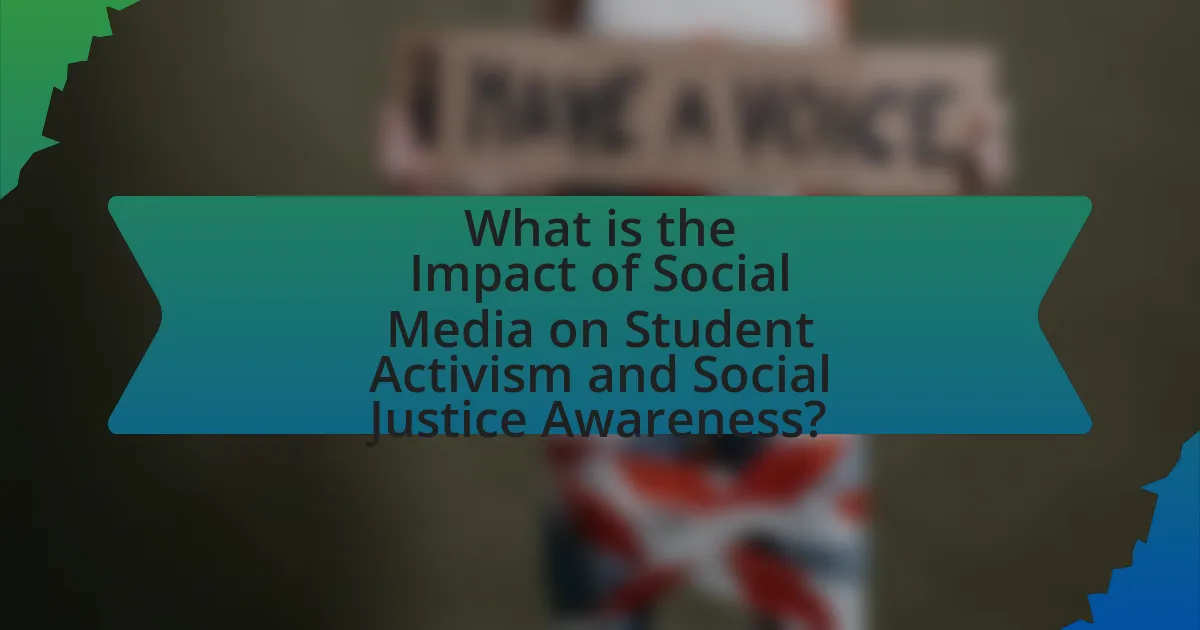
What is the Impact of Social Media on Student Activism and Social Justice Awareness?
Social media significantly enhances student activism and social justice awareness by providing a platform for rapid information dissemination and community mobilization. Platforms like Twitter and Instagram allow students to share their experiences, organize events, and amplify marginalized voices, leading to increased visibility for social justice issues. For instance, the Black Lives Matter movement gained momentum through social media, with hashtags like #BlackLivesMatter trending globally, mobilizing thousands of students to participate in protests and discussions. Research by the Pew Research Center indicates that 70% of young adults use social media to engage with political issues, demonstrating its role in shaping their activism and awareness.
How has social media transformed student activism?
Social media has transformed student activism by providing a platform for rapid communication, organization, and mobilization of movements. This transformation is evident in the ability of students to share information instantly, coordinate protests, and amplify their voices on a global scale. For instance, the #BlackLivesMatter movement gained significant traction through social media, allowing students to engage in discussions about racial injustice and organize protests effectively. Additionally, studies show that social media campaigns can increase participation in activism; for example, a 2018 study published in the Journal of Youth Studies found that social media use among students was positively correlated with their likelihood to engage in activism. This demonstrates that social media not only facilitates the spread of information but also enhances the overall impact of student-led movements.
What platforms are most influential in student activism?
Social media platforms such as Twitter, Instagram, and Facebook are the most influential in student activism. These platforms facilitate rapid information sharing, mobilization of supporters, and the organization of events. For instance, Twitter’s character limit encourages concise messaging, making it effective for real-time updates and calls to action, as seen during movements like Black Lives Matter. Instagram’s visual nature allows for impactful storytelling and engagement through images and videos, which resonate with younger audiences. Facebook serves as a community-building tool, enabling groups to form around specific causes, share resources, and coordinate efforts. Research indicates that 79% of young activists use social media to engage in political discussions, highlighting its critical role in shaping student activism.
How do social media campaigns mobilize students for social justice?
Social media campaigns mobilize students for social justice by providing a platform for awareness, engagement, and collective action. These campaigns utilize hashtags, viral content, and targeted messaging to reach a broad audience, effectively raising awareness about social justice issues. For instance, the #BlackLivesMatter movement gained significant traction through social media, leading to widespread student participation in protests and discussions. Research indicates that 70% of young people believe social media is an effective tool for activism, highlighting its role in facilitating mobilization and fostering a sense of community among students advocating for change.
Why is social media important for raising social justice awareness among students?
Social media is important for raising social justice awareness among students because it provides a platform for rapid information dissemination and community engagement. This immediacy allows students to access diverse perspectives on social justice issues, fostering informed discussions and mobilization. For instance, studies show that social media campaigns, such as #BlackLivesMatter, have significantly increased awareness and activism among young people, with 70% of students reporting that social media influenced their understanding of social justice topics. Additionally, social media enables students to connect with like-minded individuals and organizations, amplifying their voices and facilitating collective action.
What role does social media play in educating students about social justice issues?
Social media serves as a crucial platform for educating students about social justice issues by facilitating access to information, fostering discussions, and mobilizing activism. Through platforms like Twitter, Instagram, and Facebook, students can engage with diverse perspectives, share educational resources, and participate in campaigns that raise awareness about social justice topics. For instance, the hashtag #BlackLivesMatter has not only informed students about systemic racism but also encouraged them to participate in protests and discussions, demonstrating the power of social media in shaping social consciousness. Studies indicate that 70% of young people believe social media is an effective tool for social change, highlighting its role in empowering students to advocate for justice and equality.
How does social media facilitate discussions on social justice topics?
Social media facilitates discussions on social justice topics by providing a platform for diverse voices to share experiences and mobilize support. This accessibility allows individuals to engage in real-time conversations, share information, and raise awareness about social justice issues. For instance, movements like #BlackLivesMatter and #MeToo gained momentum through social media, enabling widespread dialogue and community organization. Research indicates that 70% of social media users have engaged with social justice content, highlighting its role in fostering awareness and activism.
What challenges do students face when using social media for activism?
Students face several challenges when using social media for activism, including misinformation, digital harassment, and the risk of oversimplification of complex issues. Misinformation can spread rapidly on social media platforms, leading to confusion and misrepresentation of causes, which undermines the effectiveness of activism. Digital harassment poses a significant threat, as students may encounter bullying or threats that can deter them from participating in activism. Additionally, the nature of social media often encourages oversimplification, where nuanced issues are reduced to soundbites, making it difficult for students to convey the depth of their messages. These challenges can hinder the overall impact of student activism on social justice awareness.
How do misinformation and disinformation affect student activism?
Misinformation and disinformation significantly undermine student activism by creating confusion and eroding trust in credible sources. When students encounter false information, it can lead to misguided actions and misinformed campaigns, ultimately detracting from the effectiveness of their activism. For instance, a study by the Pew Research Center found that 64% of Americans believe that misinformation has a major impact on public opinion, which directly influences student-led initiatives. Additionally, disinformation campaigns can target specific movements, such as climate change or racial justice, leading to division among student groups and diluting their collective efforts. This manipulation of information can stifle genuine discourse and hinder the mobilization of students around critical social issues.
What are the risks of online activism for students?
Online activism poses several risks for students, including potential backlash from peers, academic repercussions, and privacy concerns. Students may face social ostracism or harassment from classmates or online communities that oppose their views, which can lead to mental health issues. Additionally, schools or universities may impose disciplinary actions against students for their online activities, especially if they violate institutional policies. Privacy risks also arise, as students may inadvertently expose personal information or become targets of doxxing, where their private details are shared publicly. These risks highlight the need for students to navigate online activism carefully and be aware of the potential consequences.

How do different social media platforms influence student activism?
Different social media platforms influence student activism by providing unique tools for communication, organization, and mobilization. For instance, Twitter’s character limit encourages concise messaging, allowing students to quickly share updates and rally support for causes, as seen during the Black Lives Matter movement, where hashtags like #BlackLivesMatter gained global traction. Facebook facilitates group formation and event planning, enabling students to organize protests and discussions, evidenced by the widespread use of Facebook events for organizing marches and rallies. Instagram’s visual nature allows for impactful storytelling through images and videos, which can raise awareness and engage a broader audience, as demonstrated by campaigns like #MeToo that utilized powerful visuals to convey messages. Each platform’s distinct features shape how students engage with activism, amplifying their voices and fostering community around social justice issues.
What unique features of platforms enhance student activism?
Unique features of platforms that enhance student activism include real-time communication, broad reach, and multimedia capabilities. Real-time communication allows students to mobilize quickly and coordinate actions, as seen during movements like the Arab Spring, where social media facilitated instant updates and organization. The broad reach of platforms enables messages to spread rapidly across diverse demographics, amplifying voices that might otherwise go unheard. Additionally, multimedia capabilities allow for the sharing of videos, images, and infographics, which can effectively convey messages and evoke emotional responses, as demonstrated by campaigns like #BlackLivesMatter, where visual content played a crucial role in raising awareness and fostering engagement.
How does the visual nature of Instagram impact social justice campaigns?
The visual nature of Instagram significantly enhances the effectiveness of social justice campaigns by facilitating immediate emotional engagement and broadening audience reach. The platform’s emphasis on images and videos allows activists to convey powerful messages quickly, making complex social issues more relatable and accessible. For instance, campaigns like #BlackLivesMatter have utilized striking visuals to evoke empathy and spur action, resulting in increased awareness and participation in protests. Research indicates that posts with compelling visuals receive 94% more views than text-only content, underscoring the importance of imagery in capturing attention and driving engagement in social justice initiatives.
What role does Twitter play in real-time activism and awareness?
Twitter serves as a crucial platform for real-time activism and awareness by enabling rapid dissemination of information and mobilization of support. The platform’s character limit encourages concise messaging, allowing users to share updates, calls to action, and relevant news quickly. For instance, during the Black Lives Matter protests in 2020, Twitter was instrumental in spreading information about events, organizing protests, and raising awareness about systemic racism, with hashtags like #BlackLivesMatter trending globally. This demonstrates Twitter’s effectiveness in fostering community engagement and facilitating dialogue around social justice issues, thereby amplifying voices that might otherwise go unheard.
How do social media algorithms affect the visibility of social justice content?
Social media algorithms significantly influence the visibility of social justice content by prioritizing posts that generate higher engagement, such as likes, shares, and comments. This means that content related to social justice issues may be less visible if it does not resonate with the broader audience or fails to engage users effectively. For instance, a study by the Pew Research Center found that algorithm-driven platforms often favor sensational or emotionally charged content, which can overshadow important but less engaging social justice narratives. Consequently, this algorithmic bias can limit the reach of critical social justice discussions, making it challenging for activists to mobilize support and raise awareness.
What are the implications of algorithmic bias on student activism?
Algorithmic bias significantly undermines student activism by perpetuating inequalities and limiting the visibility of marginalized voices. When social media platforms employ biased algorithms, they often prioritize content that aligns with dominant narratives, thereby sidelining critical issues that student activists aim to highlight. For instance, research by the Data & Society Research Institute indicates that algorithmic bias can lead to the suppression of posts related to social justice movements, affecting engagement and outreach efforts. This results in a distorted representation of activism, where only certain perspectives gain traction, ultimately hindering the effectiveness of student-led initiatives for social change.
How can students navigate algorithm changes to maintain activism visibility?
Students can navigate algorithm changes to maintain activism visibility by diversifying their platforms and employing strategic content creation. By utilizing multiple social media platforms, such as Instagram, TikTok, and Twitter, students can reach different audiences and mitigate the impact of algorithm changes on any single platform. Research indicates that varied content types, including videos, infographics, and live streams, can enhance engagement and visibility, as diverse formats cater to different user preferences and algorithmic favorability. Additionally, students should engage with their audience through consistent interaction, such as responding to comments and collaborating with other activists, which can boost their content’s reach due to increased engagement metrics favored by algorithms.
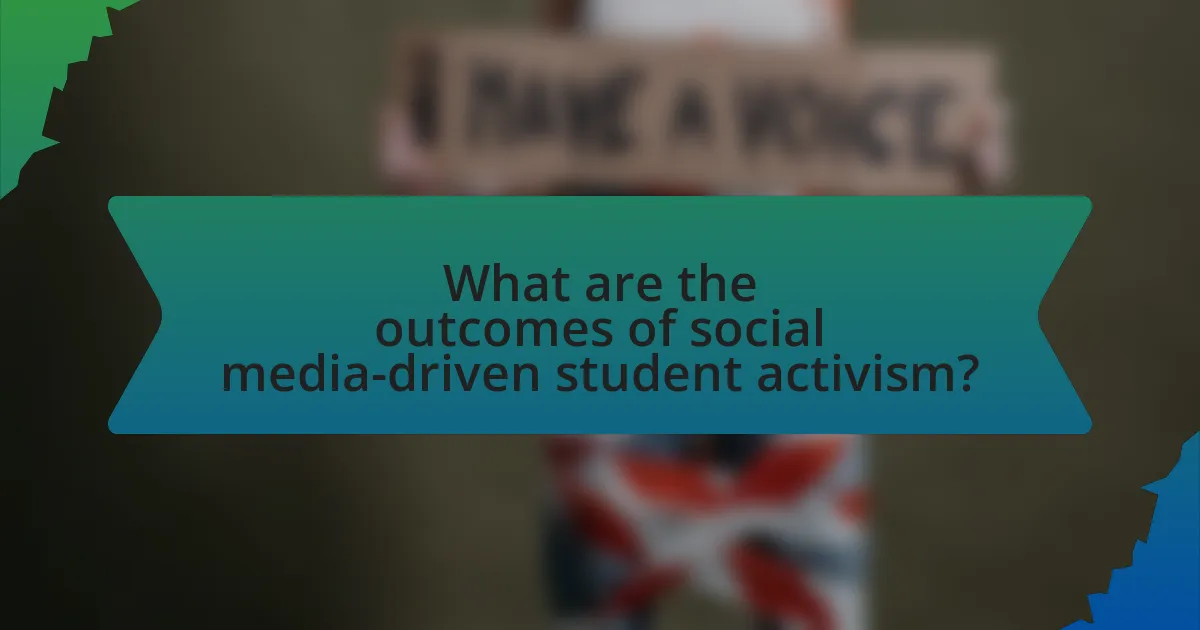
What are the outcomes of social media-driven student activism?
Social media-driven student activism leads to increased awareness, mobilization, and engagement in social justice issues. This activism often results in tangible changes, such as policy reforms, heightened visibility of marginalized voices, and the organization of protests or campaigns that attract widespread attention. For instance, the #BlackLivesMatter movement, which gained momentum through social media, has influenced legislative discussions on police reform and racial justice in various regions. Additionally, studies show that social media platforms facilitate rapid information dissemination, enabling students to connect with global movements and foster solidarity across diverse communities.
How has social media activism led to tangible social change?
Social media activism has led to tangible social change by mobilizing large groups of individuals to advocate for specific causes, resulting in policy reforms and increased public awareness. For instance, the #BlackLivesMatter movement, which gained momentum through platforms like Twitter and Instagram, has significantly influenced discussions around police reform and racial justice, leading to legislative changes in various states. Additionally, the viral spread of the #MeToo movement on social media has prompted organizations to implement stricter sexual harassment policies and has led to high-profile resignations, showcasing the direct impact of online activism on societal norms and legal frameworks.
What successful case studies illustrate the impact of social media on activism?
Successful case studies illustrating the impact of social media on activism include the #BlackLivesMatter movement and the Arab Spring. The #BlackLivesMatter movement, which gained traction in 2013, utilized platforms like Twitter and Facebook to mobilize protests against police brutality and systemic racism, leading to widespread awareness and policy discussions. According to a study by the Pew Research Center, 53% of Black Americans reported that social media helped them engage in activism. The Arab Spring, which began in 2010, saw activists use social media to organize protests against authoritarian regimes in countries like Tunisia and Egypt, resulting in significant political changes. Research published in the journal “Information, Communication & Society” highlighted that social media was crucial in facilitating communication and coordination among activists, ultimately contributing to regime changes in several nations.
How do social media campaigns influence policy changes?
Social media campaigns influence policy changes by amplifying public awareness and mobilizing collective action around specific issues. These campaigns leverage platforms like Twitter, Facebook, and Instagram to disseminate information rapidly, engage users, and create a sense of urgency. For instance, the #MeToo movement utilized social media to highlight sexual harassment and assault, leading to significant legislative changes in workplace policies across various states and countries. Research indicates that social media can increase civic engagement, with a study by the Pew Research Center showing that 69% of adults in the U.S. believe social media is an effective tool for promoting social change. This demonstrates that social media campaigns can effectively shape public discourse and influence policymakers by demonstrating widespread support for specific reforms.
What skills do students develop through social media activism?
Students develop critical skills such as digital literacy, communication, and organizational abilities through social media activism. Digital literacy enables students to navigate various platforms effectively, assess information credibility, and utilize tools for advocacy. Communication skills are honed as students craft messages, engage with diverse audiences, and mobilize support for causes. Organizational skills are enhanced through planning campaigns, coordinating events, and managing online communities. Research indicates that these skills not only empower students in activism but also prepare them for future professional environments, as effective communication and digital proficiency are highly valued in the workforce.
How does engaging in social media activism enhance critical thinking skills?
Engaging in social media activism enhances critical thinking skills by requiring individuals to analyze diverse perspectives and evaluate the credibility of information. This process involves assessing the validity of sources, understanding complex social issues, and forming well-reasoned arguments. Research indicates that individuals who participate in social media activism often engage in discussions that challenge their viewpoints, fostering a deeper understanding of the subject matter. For instance, a study published in the Journal of Educational Psychology found that students who actively participated in online debates demonstrated improved analytical skills and a greater ability to synthesize information from multiple sources.
What communication skills are fostered through online activism?
Online activism fosters several key communication skills, including digital literacy, persuasive writing, and effective messaging. Digital literacy enables activists to navigate various online platforms, understand their audiences, and utilize tools for outreach. Persuasive writing is crucial for crafting compelling messages that resonate with supporters and motivate action, as evidenced by successful campaigns that mobilize large groups through social media. Effective messaging involves the ability to convey complex social justice issues succinctly and clearly, which is essential for engaging diverse audiences and fostering dialogue. These skills are increasingly important in a digital age where communication is rapid and often requires immediate responses.
What best practices should students follow for effective social media activism?
Students should follow best practices such as creating clear and concise messages, engaging with their audience, and utilizing relevant hashtags for effective social media activism. Clear messaging ensures that the core issue is communicated effectively, while engaging with followers fosters a sense of community and encourages participation. Utilizing relevant hashtags increases visibility and connects the activism to broader conversations, as evidenced by the success of movements like #BlackLivesMatter, which gained traction through strategic hashtag use and community engagement.
How can students create impactful social media campaigns?
Students can create impactful social media campaigns by clearly defining their message and target audience. A focused message ensures that the campaign resonates with the intended audience, increasing engagement and effectiveness. For instance, campaigns that address specific social justice issues, such as climate change or racial equality, can leverage statistics and personal stories to create emotional connections. Research shows that campaigns utilizing storytelling and visual content, such as infographics or videos, can enhance message retention and sharing rates. According to a study by the Pew Research Center, 69% of adults in the U.S. use social media, making it a powerful platform for reaching diverse demographics. By employing strategic hashtags, collaborating with influencers, and engaging with followers through interactive content, students can amplify their reach and foster community involvement.
What strategies can enhance engagement and reach in social justice initiatives?
Utilizing targeted social media campaigns significantly enhances engagement and reach in social justice initiatives. These campaigns can leverage platforms like Instagram, Twitter, and TikTok to disseminate information rapidly and engage younger audiences effectively. For instance, the #BlackLivesMatter movement utilized social media to mobilize protests and raise awareness, resulting in millions of posts and widespread global support. Additionally, incorporating interactive content such as polls, live Q&A sessions, and user-generated content fosters community involvement and encourages sharing, further amplifying the initiative’s reach. Research indicates that social media campaigns can increase participation rates by up to 50%, demonstrating their effectiveness in engaging diverse audiences in social justice causes.
